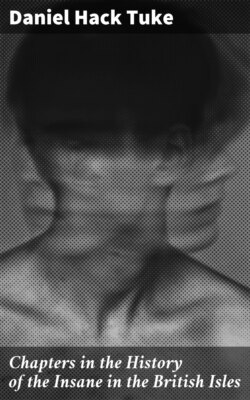Chapters in the History of the Insane in the British Isles

Реклама. ООО «ЛитРес», ИНН: 7719571260.
Оглавление
Daniel Hack Tuke. Chapters in the History of the Insane in the British Isles
Chapters in the History of the Insane in the British Isles
Table of Contents
PREFACE
Footnotes
CHAPTER I. MEDICAL AND SUPERSTITIOUS TREATMENT OF THE INSANE IN THE OLDEN TIME
Footnotes
CHAPTER II. BETHLEM HOSPITAL AND ST. LUKE'S
St. Luke's Hospital
Footnotes
CHAPTER III. EIGHTEENTH-CENTURY ASYLUMS—FOUNDATION OF THE YORK RETREAT
Footnotes
CHAPTER IV. COURSE OF LUNACY LEGISLATION
Footnotes
CHAPTER V. LINCOLN AND HANWELL—PROGRESS OF REFORM IN THE TREATMENT OF THE INSANE FROM 1844 TO THE PRESENT TIME
Footnotes
CHAPTER VI. OUR CRIMINAL LUNATICS—BROADMOOR
Footnotes
CHAPTER VII. OUR CHANCERY LUNATICS
Footnotes
CHAPTER VIII. OUR IDIOTS AND IMBECILES
Addendum
Footnotes
CHAPTER IX. SCOTLAND
Footnotes
CHAPTER X. IRELAND
Addendum
Footnotes
CHAPTER XI. PROGRESS OF PSYCHOLOGICAL MEDICINE DURING THE LAST FORTY YEARS: 1841-1881.[292]
Footnotes
CONCLUSION
Footnotes
APPENDIX A (Page 61.)
Views of Bethlem Hospital
Views of St. Luke's
APPENDIX B (Page 142.)
APPENDIX C (Page 146.)
Asylums in Operation in 1792
APPENDIX D (Page 173.)
9 Geo. IV., c. 40 (1828)
APPENDIX E (Page 188.)
8 and 9 Vict., c. 100 (1845)
APPENDIX F (Page 190.)
18 and 19 Vict., c. 105 (1855)
APPENDIX G (Page 195.)
25 and 26 Vict., c. 111, "The Lunacy Acts Amendment Act, 1862."
Private Patients
Letters of Patients
Pauper Patients
Licensed Houses and Hospitals
Medical Certificates
Workhouses
Footnotes
APPENDIX H (Page 205.)
Footnotes
APPENDIX I (Page 236.)
APPENDIX K I (Page 258.)
Footnotes
APPENDIX K II (Page 276.)
APPENDIX L (Page 284.)
APPENDIX M (Page 298.)
INDEX
A
B
C
D
E
F
G
H
I
J
K
L
M
N
O
P
Q
R
S
T
U
V
W
Y
Z
Отрывок из книги
Daniel Hack Tuke
Published by Good Press, 2021
.....
Insane persons were sometimes treated with holy water, to which salt was added, with the idea that the devil abhorred salt as the emblem of immortality (we have already had to notice this use of salt among the Saxons). Hence it was "consecrated by the papists, as profiting the health of the body, and for the banishment of demons." A certain remedial "watter," used in Scotland by wise women or herbalists, is supposed to have contained the same ingredient. Elspeth Sandisone, in 1629, was bereft of her senses. One Richart was thus accused of having tried to cure her. "Ye call the remedie 'watter forspeking,' and took watter into ane round cape and went out into the byre, and took sumthing out of your purse lyk unto great salt, and did cast thairin, and did spit thrie severall times in the samen; and ye confest yourself when ye had done so, ye aunchit in bitts, quhilk is ane Norne terme, quhilk is to say ye blew your braith thairin and thairefter ye sent it to the said Elspeth with the servand woman of the hous, and bad that the said Elspeth sould be waschit thairin, hands and feit, and scho sould be als holl as ever scho was."[34]
I may give here a curious illustration of insanity being induced, not cured, by superstition in Scotland. John Law's servant "rane wode" when John Knox had retreated to St. Andrews during the civil contentions of his later years. The story is thus quaintly told in Bannatyne's "Journal" (p. 309). John Law of that city, being in Edinburgh Castle in January, 1572, "the ladie Home wald neidis thraip in his face that he was banist the said toune because that, in the yarde reasit (rose) sum sanctis, among whome cam up the devill with hornis, which when his servant Ritchart saw, rane wode, and so deit."[35]
.....